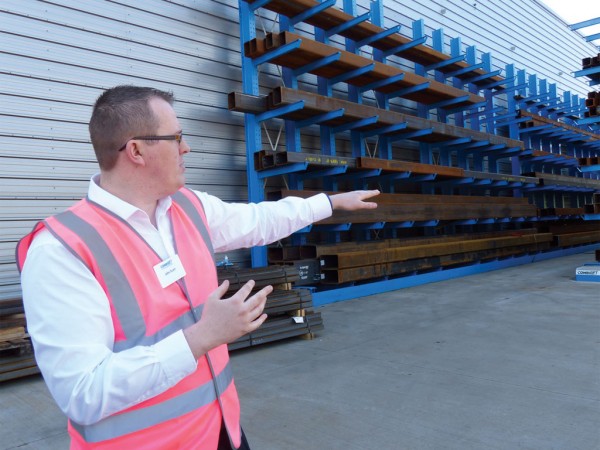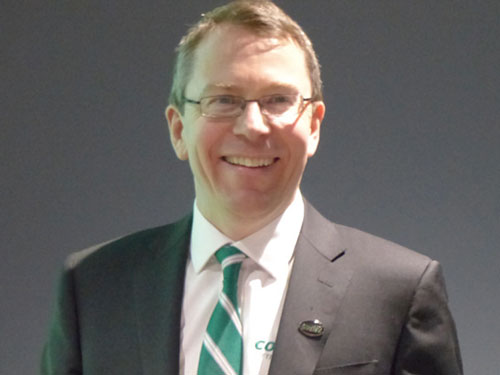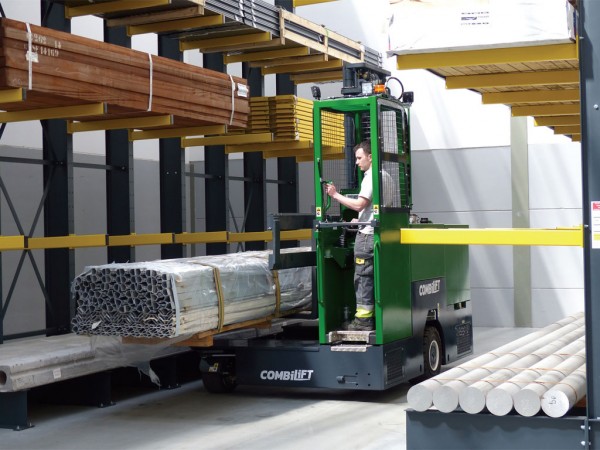Combilift’s new 500,000 sq/ft production facility in Monaghan, Ireland will enable the forklift and equipment manufacturer to keep pace with a diversified product demand.
The Irish company Combilift manufactures forklifts designed to save space on warehouse and factory floors and in yards and job sites. By contrast, Combilift’s own new factory, launched with great fanfare over recent weeks, is itself immense, with room to expand and double production as already-brisk business ramps up.
“At the old site, there were a lot of bottlenecks,” said John Scott, a member of Combilift’s marketing team, his raised voice competing with a Combilift forklift that was moving pre-cut steel from the factory yard. Scott was guiding a group of North American customers, dealers and journalists on a tour of the plant late last month, one of dozens of groups that traversed the factory. “With this new facility we can do a lot more ourselves.”
The new factory boasts of four 90-meters assembly lines, all under one sun-drenched – at least on the day of the tour – skylights dappled roof. The factory is capable of producing a finished truck every 15 minutes.
New Site
One of the largest factories in Ireland, the 500,000-square ft. complex is located outside the small town of Monaghan, about 80 miles northwest of Dublin. It’s just ten minutes from the border with Northern Ireland and two miles from Combilift’s original site.
The new complex, which cost €50 million to build, marks Combilift’s 20th anniversary and a kind of public declaration as both a global loading equipment manufacturer and a European company to be reckoned with. Combilift is the brainchild of Robert Moffett and Martin McVicar, two engineers who continue to be the company’s sole owners and board members.

With revenue last year that reached $280 million, Combilift is now ranked the world’s 13th largest forklift manufacturer, according to Modern Material Handling. Combilift’s production is growing rapidly, but continues to trail far, far behind industry leaders such as Toyota, Komatsu, KION and Crown. (Toyota is the top producer, with revenues in 2016 that topped $8.5 billion, according to Modern Material Handling.)
McVicar explained Combilift was never designed or destined to mass-produce forklifts. Instead, it is a niche producer, engaging in what McVicar called “mass customization.” This, he said, is “the new frontier for both the customer and the manufacturer as customers are increasingly expecting products to be tailored to their requirements.”

Product Diversification
For the first decade, Combilift focused on what are called “long goods,” and “long load” handling, forklifts designed to move such products as steel bars, pipes and lumber. Business was construction-industry centric. The construction slump after the global financial crisis of 2008 hit Combilift hard. In retrospect, McVicar said, the downturn was a blessing in disguise. It was “really a catalyst to diversify into more industry segments,” he said.
Making forklifts that move palletized goods in warehouses marks one major area of diversification and rapid growth for the company. These include both pedestrian stackers and articulated narrow aisle operator-driven machines, which, according to the company, can maneuver in aisles as narrow as six feet. That’s as little as half the space needed by conventional forklifts.
Catering to cold storage exemplifies how Combilift modifies its products to the needs of customers, McVicor said. He described how his company designed heated cabins for these forklifts, then, based on customer feedback, replaced glass windows with those made from a polycarbonate. That insured shards of glass don’t contaminate food in case the windows break. In addition, he said, his company discovered that the wires that heat the windows could interfere with barcode readers, so they removed the wire from an area on the door allowing operators to scan products without being exposed to the cold.

Another diversification came with the development of larger loading machines, including mobile gantries and straddle carriers, a few of which were being tested in the plant during the tour. (see story, page 4).
On the factory floor, a technician demonstrates one of the company’s newest products, a machine just launched commercially that stuffs containers through the use of a hydraulically operated steel slip sheet. This particular slip sheet stuffer is destined for a logistics company in Romania, although McVicar said that Combilift will specifically be targeting customers such as exporters that pack long, heavy products such as timber into containers. “Companies are screaming for this,” he said.
Intelligent Guidance Vehicles
Going forward, Combilift is now developing what McVicar called an “intelligent guidance vehicle,” as opposed to the automated guidance vehicles that now populate the forklift and warehouse universe. The goal is to provide unlimited flexibility in movement. “If someone sets a pallet or a regular forklift in the way, the Combilift will actually know there’s another pallet there and will change its program to navigate around what’s in front of it,” McVicar explained.
Two European companies, one in food and one in automotive manufacturing, are now testing the vehicle.
Combilift is formulating its technology with an unidentified company that worked in the mining business, where automated equipment must deal with a constantly changing landscape. “We’re calling it contour mapping,” said McVicar. “We see a lot of merits going this way. Warehouse parameters change daily.”
While flexibility rules the Combilift factory itself, “there’s very little automation in our plant. It’s still a very manual process,” McVicar said. That emphasis on its people, he believes, gives the company a great advantage. “We can tailor-make any product the customer needs in terms of tweaking it.”
It also underscores the company’s dedication to its workers. Combilift now employs 550 in its plant, with announced plans for an additional 200 jobs over the next three years. Combilift is a major employer in this largely rural farming region, with some 10% of its workforce coming from Northern Ireland. McVicar said there were absolutely no plans to move the factory to a low-cost country, music to the ears of officials and economic planners, as well as to the local populace.
McVicar explained that the company keeps labor content to 10% of its revenue. So, moving elsewhere would only save at the margins. Plus, he added, the company depends on numerous local subcontractors who fabricate many of the parts used in assembling the machines.
“When you have expertise here, [moving] is not even something to consider,” he emphasized. “The people that we have here is what makes the business.”





